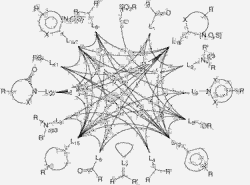BRICS
Modelling of chemical space based on prominent chemical motifs of known inhibitors and commercially available compounds.
|
BRICS consists of a representation of chemical environments for the generation and recombination of fragments based on a comprehensive and easily adaptable set of rules. BRICS can serve as a basis for various molecular design objectives, including
|
To cite BRICS and for details please refer to the following publication:
- Degen, J, Wegscheid-Gerlach, C., Zaliani, A., Rarey, M. (2008). On the Art of Compiling and Using 'Drug-Like' Chemical Fragment Spaces. ChemMedChem, 3:1503-1507. [DOI]
Scope and limitations
- We provide three differently sized fragment collections based on the BRICS model.
- In this context, a fragment is a small molecule with explicitly modeled attachment points ('Links').
- We further provide a corresponding set of rules for the recombination of fragments (more details).
- We include input data files for our structure-based de novo design program Flex Novo and for combinatorial similarity searching with FTrees-FS.
- In principle, the fragments can also be used 'as is' and for docking with, for example, FlexX.
To obtain BRICS please read and accept the disclaimer for details on usage, privacy, data storage, and related issues. Please note:
- The BRICS fragment collections are for internal use only.
- The BRICS fragment collections must not be re-distributed.
People and references
BRICS was developed in a joint effort by Jörg Degen, Andrea Zaliani and Matthias Rarey in the research group for computational molecular design at the Center for Bioinformatics of the University of Hamburg and Christof Wegscheid-Gerlach at Bayer Schering Pharma AG in Berlin.
We are grateful to all partners of the NovoBench project and to the German Federal Ministry of Education and Research (BMBF) for partial funding (grant 313324A).
Obtaining and contents
To obtain the BRICS fragment sets/spaces, please read and accept the disclaimer.
Up until now, we provide three fragment collections from increasingly large intersections of fragments derived with the BRICS model from the World Drug Index and the 'drug-like' subset of the ZINC database. All of these are publicly available in 3D (mol2) format. In addition, we provide input data files (fsf) for direct use with FlexNovo and FTrees-FS.
| Fragment set/space | # fragments | last update | input data files |
| BRICS_2008_4k | 4800 | 26.09.2008 | mol2 and fsf |
| BRICS_2008_9k | 9344 | 26.09.2008 | mol2 and fsf |
| BRICS_2008_20k | 22343 | 26.09.2008 | mol2 and fsf |

